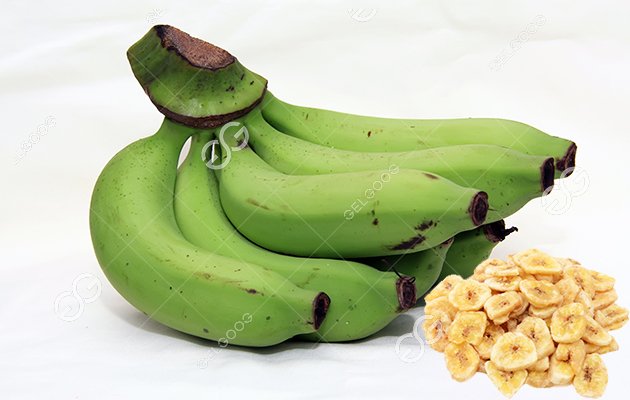What Is The Process of Producing Plantain Chips?
Jun 06, 2024 | Emily
 143
143
 143
143
The process of producing plantain chips is a complex industrial process that requires several steps and specialized plantain chip production equipment. Below is the detailed plantain chips producing process:

Preparation of raw materials
The first step in the production of plantain chips is the selection of fresh plantains. Factories usually have contracts with farms to ensure a steady supply of high quality plantains. Upon arrival at the factory, the plantains undergo an initial inspection to eliminate those that do not meet standards.
Peeling
When plantains arrive at the factory, they are first peeled. Traditional manual peeling is inefficient and unsuitable for mass production, so modern factories tend to use mechanical peeling equipment.
Slicing
Peeled plantains are transported on a conveyor belt to a slicer. The slicer can usually adjust the thickness of the slices to meet different market demands. The slicing process requires precision, as the thickness of the slices directly affects the uniformity of the subsequent frying and the texture of the final product. Standard plantain slices are usually between 3-5 millimeters thick.
Frying
The cut plantain slices will go to the deep frying stage. This is one of the most critical parts of the entire production process. Frying equipment is usually continuous, with the plantain slices slowly passing through a conveyor belt through a high-temperature oil tank. The frying temperature is usually controlled at 150-180 degrees Celsius for about 2-3 minutes. This process requires precise control of the oil temperature and frying time to ensure that the plantain chips are crispy and not burnt.
Deoiling
After frying, the surface of plantain chips is left with a lot of grease, which needs to be degreased. Usually, factories use centrifugal degreasing machines that spin at high speeds to shake out the excess oil. This step not only reduces the greasiness of the plantain chips, but also extends their shelf life.
Cooling
plantain chips after deoiling are at a high temperature and need to be cooled quickly to room temperature to maintain their crunchy texture. Cooling equipment is usually air-cooled, utilizing cold air to quickly remove heat. The cooling time is generally a few minutes, depending on the specific equipment and environmental conditions.
Packaging
The cooled plantain chips enter the packaging process. Packaging materials are usually aluminum foil bags or composite film bags with good moisture and oxygen barrier properties. The packaging machine automatically performs dosing, filling and sealing operations. To extend the shelf life of plantain chips, the bags are usually filled with a small amount of inert gas, such as nitrogen, to prevent oxidation.
The process of producing plantain chips in a factory has many steps, but each of them has its own importance. These processes not only increase production efficiency, but also guarantee the safety and consistency of the product.

Preparation of raw materials
The first step in the production of plantain chips is the selection of fresh plantains. Factories usually have contracts with farms to ensure a steady supply of high quality plantains. Upon arrival at the factory, the plantains undergo an initial inspection to eliminate those that do not meet standards.
Peeling
When plantains arrive at the factory, they are first peeled. Traditional manual peeling is inefficient and unsuitable for mass production, so modern factories tend to use mechanical peeling equipment.
Slicing
Peeled plantains are transported on a conveyor belt to a slicer. The slicer can usually adjust the thickness of the slices to meet different market demands. The slicing process requires precision, as the thickness of the slices directly affects the uniformity of the subsequent frying and the texture of the final product. Standard plantain slices are usually between 3-5 millimeters thick.
Frying
The cut plantain slices will go to the deep frying stage. This is one of the most critical parts of the entire production process. Frying equipment is usually continuous, with the plantain slices slowly passing through a conveyor belt through a high-temperature oil tank. The frying temperature is usually controlled at 150-180 degrees Celsius for about 2-3 minutes. This process requires precise control of the oil temperature and frying time to ensure that the plantain chips are crispy and not burnt.
Deoiling
After frying, the surface of plantain chips is left with a lot of grease, which needs to be degreased. Usually, factories use centrifugal degreasing machines that spin at high speeds to shake out the excess oil. This step not only reduces the greasiness of the plantain chips, but also extends their shelf life.
Cooling
plantain chips after deoiling are at a high temperature and need to be cooled quickly to room temperature to maintain their crunchy texture. Cooling equipment is usually air-cooled, utilizing cold air to quickly remove heat. The cooling time is generally a few minutes, depending on the specific equipment and environmental conditions.
Packaging
The cooled plantain chips enter the packaging process. Packaging materials are usually aluminum foil bags or composite film bags with good moisture and oxygen barrier properties. The packaging machine automatically performs dosing, filling and sealing operations. To extend the shelf life of plantain chips, the bags are usually filled with a small amount of inert gas, such as nitrogen, to prevent oxidation.
The process of producing plantain chips in a factory has many steps, but each of them has its own importance. These processes not only increase production efficiency, but also guarantee the safety and consistency of the product.

 Tel:0086-15515573212
Tel:0086-15515573212  E-mail:sherry@gelgoog.com
E-mail:sherry@gelgoog.com 
